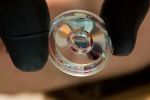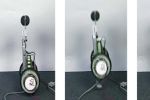The PopSci Movie Science Awards
The Academy Awards are nearly upon us, and this year we've got three films nominated in multiple Academy categories, each of which also fits the bill for our own PopSci Movie Science Awards. These distinguished nominees consist of the 2008 blockbusters The Dark Knight, Ironman, and Wall-E. Each of these movies, enveloped in their superhero/science fiction-esque and/or computer graphic wrappings, give those of us so inclined a springboard into discussing and analyzing a little bit of Hollywood science.
Remember, kids, this is intended to be fun. We're not here to offend those who repeatedly remind me that "it's only a @&*#* movie!" We promise not to recklessly poke holes in some obvious fantasies -- I mean it would be pretty silly to criticize the physics of the computer animated Wall-E -- so our program will be to assess how each of these movies can be used as an educational tool. What relevant scientific ideas are brought up? How interestingly are these presented? Are there any particularly vivid or accurate representations of some fundamental scientific principle? And what are the standard Hollywood misrepresentations demonstrated by our three nominees?
First let's introduce the awards:
1) Most Interesting Scientific Idea Represented in a Big-Budget Hollywood Action-Packed Blockbuster.
2) Most Accurate Physics.
3) Most (Surprisingly) Educational.
4) Best Supporting Actor.
Now let's summarize each film for its salient features before awarding our hopeful nominees. Ready? Set. Here we go!
The Dark Knight
Before we talk science, let's just put this out there straight away. The award for Best Supporting Actor goes to ... Heath Ledger. In an incredibly nuanced, original, fascinatingly detailed, and entertaining performance, the late Mr. Ledger steals the movie. It is a performance well deserving of a Best Supporting Actor Academy Award.
As far as the science goes, we've discussed in a controversial previous article on this site a number of action sequences where we apply some "movie physics" analyses. The general conclusion is that the scenes are typical of the high-octane action/superhero genre and demonstrate the characteristic Hollywood extended unreality.
However, an interesting variation on the usual fare includes the use of actual Batmobile prototypes in the filming. These were designed for high performance and are used in many of the stunts, rather than being simulated with computer graphics technology.
Furthermore, although it would be an understatement to point out that there are some big explosions in The Dark Knight, it's kind of refreshing that these explosions don't occur every time a car crashes (not that there aren't a prodigious quantity of automobile collisions throughout the movie).
The exploding car has become a rather silly Hollywood cliché. Watch the Mission: Impossible movies or a James Bond film. Almost every time a car crashes or gets nicked by a bullet it explodes. It becomes rather irritating after a while. How hard is it for a car to really explode? Well, it's really hard. A specific ratio of gasoline vapor to liquid within a very small range is required -- and a spark. And if you think a bullet fired into the gas tank will do the job, check out Mythbusters. Anyway, congratulations to The Dark Knight for some restraint in this area at least.
Arguably the most interesting scientific application woven into the plot of the film involves the use of cell phone technology. While using these as radar-like imaging devices (as they do to map out the interior of Mr. Lau's office building) would have some serious technological difficulties, eavesdropping by intercepting cell phone transmissions and remotely activating cell phone microphones, even when the phone is turned off, is possible and in fact has been used by the FBI for surveillance purposes.
Popular Tags
Entertainment & Gaming
Regular Features

| regarding | user | just commented |
|---|---|---|
| What Should Happen to the Body if an Astronaut Dies on Mars? | htof | goooood ^_^ > منتديات |
| Call the Space Plumber: ISS's Toilet is on the Fritz | htof | منتديات توبيكات |
| Greening the World of Warcraft? | Karl777 | There are already stories of |
| PSP 3000 to Come in Colours | Karl777 | In terms of features, |
| NASA’s US$280 Million Satellite Destroyed | Ulyssus | Its always amusing how NASA |
Featured
Entertainment & Gaming
Balls and Bullets For Bucks
While online poker remains in cloudy legal waters, betting on games of skill can still net you some quick cash—if you're good enough to beat the competitionHollywood Science: How to Make a Digital World
The high-speed stunner Speed Racer resets reality by creating a fantasyland out of nothing but computers and imagination
Popular on Popsci
Most Viewed
Most Commented
Entertainment & Gaming
- The Downfall of Plasma?
- Taking 10 Volts Straight to the Face
- Greening the World of Warcraft?
- Friday YouTube: Super Mario 64 Record Run
- The Simpsons Goes HD
- PSP 3000 to Come in Colours
- Cross Battle Adaptor Brings Xbox 360 Controller to PS3, With Rumble
- Sony Creates World’s Largest Zoetrope
- Is PC Gaming Dead?
- Animation Wins Big
Most Emailed
Entertainment & Gaming
- PSP 3000 to Come in Colours
- Greening the World of Warcraft?
- Animation Wins Big
- Animation Wins Big
- The PopSci Movie Science Awards
- Cross Battle Adaptor Brings Xbox 360 Controller to PS3, With Rumble
- Friday YouTube: Super Mario 64 Record Run
- Build a Bridge
- Killzone 2 Preview for Playstation 3
- Sony Creates World’s Largest Zoetrope








